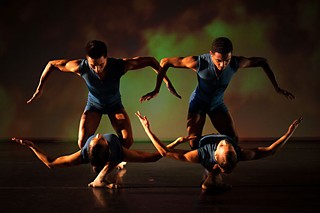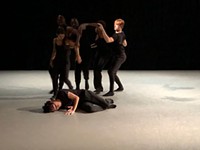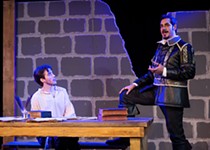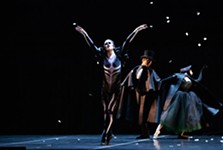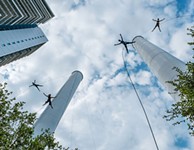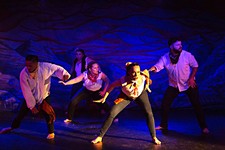Fall for Dance
Dance Repertory Theatre's program was divided between live and canned music, with the live half clearly deeper
Reviewed by Jonelle Seitz, Fri., Nov. 22, 2013
B. Iden Payne Theatre, 300 E. 23rd, UT campus
www.utexas.edu/finearts/tad
Through Nov. 24
Is Dance Repertory Theatre in the midst of a transition, or are its artistic directors, professors David Justin and Holly Williams, trying to teach us something? The juxtaposition of the halves of DRT's divided program seems almost didactic: the second half, with live music, is clearly of a deeper realm than is the first half, with canned.
Justin's "Quiver," developed from an earlier version, opens the deeper half with a 21st century nuzzling against Bach's Partita No. 2 in D Minor. Violinist Molly Emerman's performance is the catalyst for the movements of four women and two men, in costume designer Luciao Wang's space-age cerulean bodysuits and skin-toned socks (in amending the bare foot, the sock reads as both techno and disarmingly intimate). With searching, intricate partnering sequences, the dancers seem to search for ways to get closer to the music; in open, front-facing pauses, they show us how to acknowledge the simple friction and warmth of the instrument.
While "Quiver" is an enthralling, intelligent, and poignant work, the concert's finale, Mark Morris' 1993 "Grand Duo," might be a masterpiece. A jewel-toned group dance to Lou Harrison's haunting-to-thrilling Grand Duo for Piano and Violin (performed by Emerman and Nicholas Reynolds), the work is like a richer, warmer, more carpe diem Rite of Spring. In the final circle dance, to an exhilarating, hammered-out polka, the dancers make breakneck gestures and fling their legs up toward the flies in strength, joy, mirth. "Grand Duo," on the heels of DRT's recent performances of works by Ohad Naharin and Paul Taylor, is the newest, and biggest, triumph for the University of Texas Department of Theatre & Dance program.
These two works left me with memories and imagery – less of the sounds and movement themselves than of the qualities of sound, the blur of movement, the essence of life, and the intangible things in between – that will stay with me for a while. Of the first half of the program, I can relay facts: "Raw," by Yoav Kaddar, is a pseudo-primal teased-hair thing to recorded percussion. "Unspeakable Truths," by undergraduate Stacy Skolnik, shows promise but is marred by an alternately irksome and forgettable synthesized soundtrack. Holly Williams' "Orchid," to a song by Israel "IZ" Kamakawiwo'ole, is all smiles but has little of the complexity evoked by its namesake. But did these three works leave me with anything I'd mourn over losing? Nah.
I'm certain it's not just me. The needs of today's audiences to feel continually, exponentially more from performance is real, as is our desensitization to recorded music because of its ubiquity. The fact that some of the faculty as well as the students – especially, in the opening night cast, Erica Saucedo, Rebecca Bagley, and Eleah Maxfield – view this scenario as a call to go all-in is a pretty big deal.





